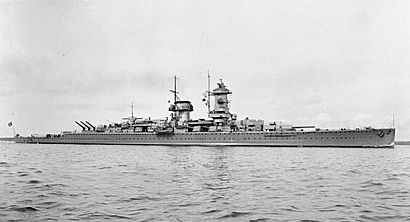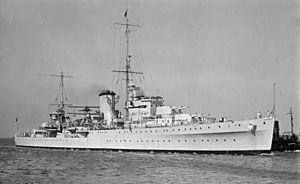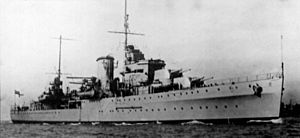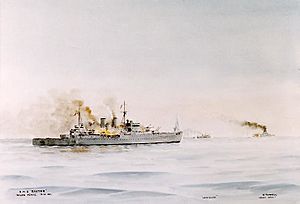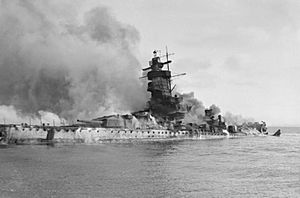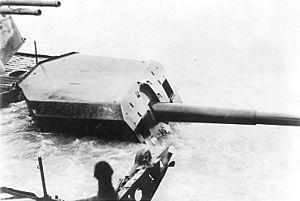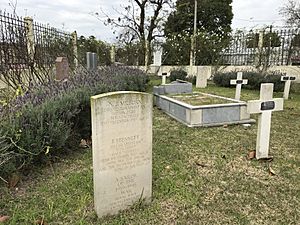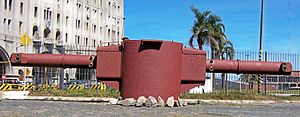Battle of the River Plate facts for kids
Quick facts for kids Battle of the River Plate |
|||||||
|---|---|---|---|---|---|---|---|
| Part of the American Theatre of World War II | |||||||
 HMS Achilles as seen from HMS Ajax during the battle |
|||||||
|
|||||||
| Belligerents | |||||||
| Commanders and leaders | |||||||
| Strength | |||||||
| 1 heavy cruiser 2 light cruisers |
1 Panzerschiff (heavy cruiser) | ||||||
| Casualties and losses | |||||||
| 72 killed 28 wounded 1 heavy cruiser heavily damaged 2 light cruisers moderately damaged |
36 killed 60 wounded Admiral Graf Spee critically damaged, later scuttled as a result |
||||||
The Battle of the River Plate was the very first major naval battle of World War II. It happened on December 13, 1939, in the South Atlantic Ocean. In this battle, a powerful German warship called the Admiral Graf Spee fought against three British Royal Navy ships.
The German ship, commanded by Captain Hans Langsdorff, was a type of heavy cruiser. The British squadron was led by Commodore Henry Harwood. His ships were the light cruisers HMS Ajax and HMS Achilles, and the heavy cruiser HMS Exeter. The Achilles was on loan to the New Zealand Navy.
Before the battle, the Graf Spee had been sinking merchant ships in the Atlantic. The British ships were hunting for it. They found the Graf Spee near the mouth of the River Plate in South America. This area is close to Argentina and Uruguay.
During the fight, the British ship Exeter was badly damaged. The Ajax and Achilles also took some hits. The Graf Spee was damaged too, especially its fuel system. This damage was critical, meaning it couldn't travel far. The British ships then followed the Graf Spee as it went into the port of Montevideo, the capital of neutral Uruguay.
Captain Langsdorff was told he could only stay for 72 hours. He believed the British had gathered a much stronger force outside the port. So, he decided to sink his own ship to prevent it from being captured. Captain Langsdorff died three days later.
Contents
What Happened Before the Battle?
The Admiral Graf Spee was already at sea when World War II began in September 1939. Its job was to sink enemy merchant ships. It had sunk several ships in the Indian Ocean and South Atlantic Ocean. Captain Langsdorff always made sure the crews of the sunken ships were rescued first.
The Royal Navy sent out nine groups of ships to find the Graf Spee. One of these groups was Force G, led by Commodore Henry Harwood. His flagship was the light cruiser Ajax. The other ships in his group were the heavy cruiser Exeter and the light cruiser Achilles. Another heavy cruiser, HMS Cumberland, was getting repairs in the Falkland Islands but was ready to join if needed.
A merchant ship called Doric Star sent a warning message before the Graf Spee sank it. This made Commodore Harwood think the Graf Spee would attack shipping near the River Plate. He ordered his ships to go to that area. This spot was chosen because it was a busy shipping route.
Harwood had a plan for fighting a powerful German ship with his smaller cruisers. He decided that his ships should attack right away, day or night. During the day, they would attack from two sides. This would force the German ship to split its fire, making its powerful guns less effective. This strategy gave his lighter ships a better chance.
The British ships were outgunned by the Graf Spee. However, the British had a bigger plan. If they could damage the Graf Spee enough, it wouldn't be able to return to Germany. The loss of a few British cruisers would not greatly harm Britain's navy. But the Graf Spee was one of Germany's few large warships. So, damaging it was a big win for the British.
How the Battle Began
On December 13, 1939, at 5:20 AM, the British ships were sailing. At 6:10 AM, they saw smoke in the distance. Harwood ordered the Exeter to check it out. At 6:16 AM, the Exeter signaled, "I think it is a pocket-battleship." This was the Admiral Graf Spee.
The Graf Spee had also seen the British ships. Its captain, Langsdorff, first thought the two light cruisers were smaller destroyers. He believed the British ships were protecting a group of merchant ships. He wanted to attack them.
Langsdorff soon realized he was facing three cruisers. He decided to close in quickly, hoping to attack the British ships before they could reach full speed. He could have tried to stay far away and use his bigger guns. But he knew the British ships were faster and could call for help.
The British ships followed their battle plan. The Exeter turned one way, and the Ajax and Achilles turned another. This made the Graf Spee have to split its fire. The Graf Spee opened fire on the Exeter at 6:18 AM. The British ships fired back a few minutes later.
The Graf Spee's shots were very accurate. Its shells hit the Exeter early in the battle. One shell damaged the ship's communications and destroyed its aircraft. Another hit a gun turret, putting it out of action. Shrapnel (small pieces of metal) injured or killed many on the bridge. The Exeter was badly damaged and had to be steered by messengers.
Meanwhile, the Ajax and Achilles moved closer to the Graf Spee. This forced the German ship to use its smaller guns on them. The Exeter fired torpedoes, but they missed. The Exeter was hit two more times by large shells. One hit another gun turret, putting it out of action. The ship was flooding and leaning to one side.
However, the Exeter landed a very important hit. One of its shells went through two decks of the Graf Spee. It exploded in the ship's fuel system area. This meant the Graf Spee had only 16 hours of fuel left. It was not enough to get back to Germany.
At this point, the Graf Spee was in serious trouble. It couldn't fix its fuel system during the battle. Many of its anti-aircraft guns were also destroyed. It had no friendly naval bases nearby and no reinforcements coming. The ship was not safe to sail on the open ocean. It could only go to the neutral port of Montevideo.
The Graf Spee then turned away and made a smoke screen. The Exeter was still firing with its last working gun, but it was too damaged to continue. Captain Bell had to pull the Exeter out of the fight. The Ajax and Achilles then drew the Graf Spee's attention.
The two light cruisers tried to get closer to the Graf Spee. The Graf Spee fired back, forcing them to turn away. The Ajax fired its torpedoes, making the Graf Spee turn away again. The Ajax was hit by a large shell, damaging its mast and causing more injuries. By 7:40 AM, the British ships were running low on ammunition.
Commodore Harwood decided to change tactics. He would follow the Graf Spee and try to attack again at night. At night, he could use torpedoes and his ships' speed and agility more effectively. The Graf Spee continued sailing southwest.
The Pursuit and the Trap
The battle turned into a chase. The British and New Zealand cruisers stayed about 15 miles from the Admiral Graf Spee. They kept watch on both sides of the German ship. At 9:46 AM, Harwood asked the Cumberland for help. The British Admiralty also ordered other ships to head towards the River Plate.
The Graf Spee sent a radio message asking the Ajax to pick up lifeboats from an English merchant ship it had stopped. This message confirmed to Harwood that it was indeed the Admiral Graf Spee. The British ships continued to follow the German ship all day.
It became clear that the Admiral Graf Spee was heading into the River Plate estuary. This area has sandbanks, so Harwood ordered the Achilles to follow closely. The Ajax would watch for any attempts by the Graf Spee to escape through a different channel. As the sun set, the Graf Spee was silhouetted against the sky. The Achilles got too close, and the Graf Spee fired, forcing the Achilles to turn away. In total, 108 people were killed on both sides during the battle.
The Admiral Graf Spee entered Montevideo, Uruguay, just after midnight on December 14. This was a mistake because Uruguay, while neutral, was friendly towards Britain. The British Hospital in the city, where the wounded were taken, was the best hospital there. A port in Argentina would have been a better choice for the Graf Spee. Also, if the Graf Spee had left port right away, it would have only faced the damaged Ajax and Achilles.
The Montevideo Standoff
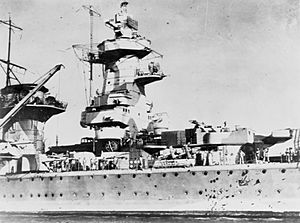
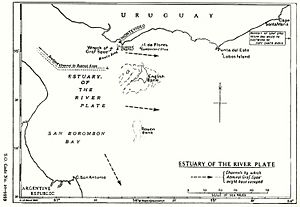
In Montevideo, international rules about neutral ports came into play. Warships were not allowed to stay in a neutral port for more than 24 hours unless they needed repairs. The German captain asked for two weeks to make repairs.
British diplomats in Uruguay, especially Eugen Millington-Drake, pushed for the Admiral Graf Spee to leave quickly. They knew there were no strong British naval forces nearby yet. At the same time, the British arranged for their merchant ships to leave Montevideo every 24 hours. This used another rule that said a warship could not leave a neutral port until 24 hours after an enemy merchant ship had left. This kept the Graf Spee stuck in port, giving the British more time for their ships to arrive.
The British also tried to trick the Germans. They sent out fake radio messages that German intelligence could hear. These messages suggested that a huge British force, including an aircraft carrier and a battlecruiser, was gathering. In reality, only the Cumberland had arrived. It had sailed very fast from the Falkland Islands. The Cumberland was powerful but still not a match for the Graf Spee's bigger guns. Other British ships were on their way but would not arrive for several days. To make the trick more believable, the British ships waiting outside the port made smoke, which could be seen from Montevideo.
The Germans were completely fooled. They believed they would face a much stronger force if they left the River Plate. The Admiral Graf Spee had also used up two-thirds of its main ammunition. It only had enough left for about 20 minutes of fighting. This was not enough to fight its way out against the large force it expected.
Captain Langsdorff talked with his commanders in Germany. He was given some choices, but not to stay in Uruguay. Germany feared Uruguay might join the Allies. So, on December 17, Langsdorff decided to sink his ship in the River Plate estuary. He did this to avoid losing more lives for no military gain. This decision made Adolf Hitler very angry.
The crew of the Admiral Graf Spee went to Buenos Aires, Argentina. Captain Langsdorff died there on December 19 and was buried with military honors. Many British officers attended his funeral. Many German crew members later settled in Montevideo and Argentina.
What Happened Next
The German government had claimed that the Admiral Graf Spee had sunk a heavy cruiser and badly damaged two light cruisers, with only minor damage to itself. So, the sinking of the Graf Spee was a big embarrassment for them.
For the British, the battle was a major victory. The damage to the Ajax and Achilles was not severe enough to stop them from fighting. The Exeter, though badly damaged, made it to the Falkland Islands for emergency repairs. The British Prime Minister, Winston Churchill, insisted that the Exeter be repaired and sent back to England. It took 13 months to fix the ship.
Commodore Harwood was praised for his actions. However, some people criticized him for not being more aggressive and letting the Graf Spee escape, even though his ships outnumbered it.
The German sailors who were captured from merchant ships by the Graf Spee had been moved to its supply ship, the Altmark. These prisoners were later freed by British sailors in the Altmark incident in Norway. The prisoners who were still on the Graf Spee during the battle were released when the ship arrived in Montevideo.
On December 22, 1939, over 1,000 sailors from the Admiral Graf Spee were taken to Buenos Aires and kept there. Many of these sailors later settled in Argentina and Uruguay. The German sailors who died in the battle were buried in Montevideo. British sailors who died were buried at sea or in the British Cemetery in Montevideo.
Finding Parts of the Ship
After the Admiral Graf Spee was sunk, it rested in shallow water. Much of the ship's top parts were still above the water. Over the years, the wreck has sunk deeper into the mud. Now, only the tip of its mast can be seen.
Experts were sent to Montevideo to study the wreck. In 1997, one of the Graf Spee's secondary gun mounts was brought up and fixed. You can now see it outside Montevideo's National Maritime Museum.
In 2004, a team started working to raise the rest of the wreck. This is being paid for by the government of Uruguay and private groups. The wreck is a danger to ships in the area. The first big piece, a heavy gunnery control station, was raised in February 2004. It will take several years to raise the whole ship. The plan is to restore it and display it in the National Marine Museum.
However, many German veterans did not like this plan. They believe the wreck is a war grave and should be left alone.
In 2006, a large eagle and swastika crest from the back of the Admiral Graf Spee was recovered. This eagle statue was a common feature on German warships before the war. To avoid upsetting people who remember Nazi Germany, the swastika was covered when it was pulled from the water. The statue is now kept in a Uruguayan naval warehouse.
The Battle's Lasting Impact
In 1956, a movie called The Battle of the River Plate was made about the battle. The real HMS Achilles even played itself in the film! Other ships in the movie were played by different warships.
A British destroyer was named HMS River Plate after the battle.
For many years, the battle was re-enacted with large model boats in Peasholm Park in Scarborough, England. Now, the re-enactment shows a general battle between British ships and an unknown enemy.
After the battle, a new town in Canada, built for making weapons during World War II, was named Ajax, Ontario, after HMS Ajax. Many of its streets are named after the British crewmen and commanders from the battle. The main street is named after Admiral Harwood. A small street was even named after Captain Langsdorff, as he was seen as a brave officer, not a typical Nazi.
In Canada, several Cadet Corps (youth groups) are also named after the ships and commanders from the battle.
Many streets in places like Nelson Bay, Australia, and Auckland, New Zealand, are named after the ships and places from the battle.
The Battle of the River Plate is also important because it was the first time the Flag of New Zealand was flown in battle, from HMS Achilles. In New Zealand, four mountains are named after the ships: Achilles, Exeter, Ajax, and Graf Spee.
See also
 In Spanish: Batalla del Río de la Plata para niños
In Spanish: Batalla del Río de la Plata para niños


